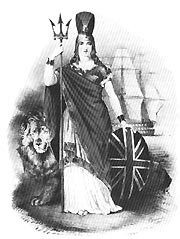
His article is in response to the controversy surrounding the government’s plan to amend the 1701 Act of Settlement so that a first-born girl can succeed to the throne, rather than being second in line to her younger brother. This would mean that if Prince William and Kate Middleton have a baby girl first, then she could be our future queen.
As Sandbrook points out, the plans to amend the act have been met with horror from constitutional conservatives, but Sandbrook rightly points out that “throughout our long royal history, the female of the species has generally proved far more competent than the male.” He goes on to say:-
“A glance at the names of some of England’s past queens — Matilda, Bloody Mary, Elizabeth I, Victoria — is enough to make even brave male observers blanch. And few of us doubt that our current Queen is made of pretty stern stuff.
And while Prince Charles’s fondness for talking to plants would horrify some of his medieval predecessors, the warrior kings of old would surely warm to his sister Anne, whose steely demeanour leaves little doubt that she would make a fine heir to William the Conqueror and Richard the Lionheart.”
It does make you wonder why, in our age of supposed equality, the law has not already been changed. I’m no feminist but as someone who has done research into the reigns of Elizabeth I and Victoria, and who adores strong historical women like Eleanor of Aquitaine, Isabella of Castile, Anne Boleyn, I cannot see any justification for the law being left as it is.
In his wonderful article, Sandbrook looks at examples of female rulers in history:-
-
- Matilda, the daughter of Henry I – Sandbrook compares her to the man she fought for her right to inherit the throne from her father, her cousin, Stephen. Sandbrook describes Matilda as “formidable”, “a fighter”, and as having “sheer guts and spirit”, and quotes one chronicler as saying that Stephen was “softe and gode, who no justice did”. Although Stephen won in the end, Matilda succeeded in securing the succession for her son, Henry II.
- Mary I – Although she is often remembered as “Bloody Mary”, the cruel queen who burned so many Protestants at the stake, Sandbrook says “as the first ruling English queen, she impressed contemporaries with her courage and decisiveness.”
- Elizabeth I – “Elizabeth’s story is the perfect illustration of the challenges facing a female ruler. After the execution of her mother Anne Boleyn, she had been declared illegitimate. Later, during her sister Mary’s reign, she was locked in the Tower of London and threatened with trial for treason”, says Sandbrook, and it is true that Elizabeth faced such challenges with courage and determination. Her reign is seen as a “golden age” and she is recognised, quite rightly, as being one of England’s finest monarchs. Sandbrook compares her to the likes of John, Edward II, Henry VI and George IV, kings he labels as “weaklings” who “would have buckled under the pressure” that Elizabeth was put under. In her famous Tilbury speech, Elizabeth spoke of how she had “the heart and stomach of a king” and as she rallied the troops with her fighting talk, she “seemed the incarnation of Britannia herself” and “once and for all she banished the notion that a woman could not rule a male-dominated kingdom.”
- Queen Anne – Sandbrook points out that although she is remembered for her 18 pregnancies and ill health, “Anne proved a highly successful monarch, presiding over the union of England and Scotland, the glorious triumph over the French at Blenheim, and the first stirrings of Britain’s commercial empire.”
- Queen Victoria – Victoria reigned for 63 years and although the UK had a constitutional monarchy when she came to the throne, she did have an influence on government policy and, as her Wikipedia page points out “she became the iconic symbol of the nation and empire, and was identified with strict standards of personal morality.” Today, she is often referred to as “The Grandmother of Europe” because she successfully arranged marriages between her children and royal and noble families across Europe. Also, Victoria was not only Queen, she was also the Empress of India. Those were the days of the British Empire.
- Elizabeth II – Of our present queen, Sandbrook says, “nobody could deny that the Queen has shown extraordinary reserves of resilience and skill since her accession in 1952. To have ruled for so long is a miracle of stamina; to have done so with such grace and charm is almost superhuman.” The Queen has indeed faced many challenges: the scandals surrounding her family, the breakdown of her children’s marriages, Diana’s death, criticism of her relationship with Diana etc. etc. but she has risen above it all to be a woman who is respected and adored.
Dominic Sandbrook doesn’t stop at queens, he also considers British female politicians like Barbara Castle and Margaret Thatcher, and I think we can add Mo Mowlam to that list too, and I’m sure that you can think of other women who have shown themselves as formidable opponents in the rather male dominated world of politics.
I love Sandbrook’s conclusion:-
“Perhaps our women rulers proved so redoubtable because, surrounded by men, they had to work so much harder to win respect. Or perhaps the old adage is true, and the female of the species really is deadlier than the male.
In any case, since we have generally been better off under the leadership of a strong woman, the proposed reform is nothing to be frightened of. Indeed, given the record of history, surely it does not go far enough.
If we really want to recapture Britain’s lost glory, then we should simply amend the law to ensure that the crown always goes to a woman.”
He he!
Source
- Why we should ALWAYS give the crown to a woman, Dominic Sandbrook in The Daily Mail, 21st January 2011






